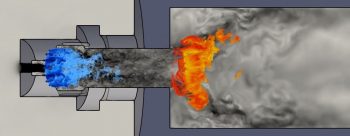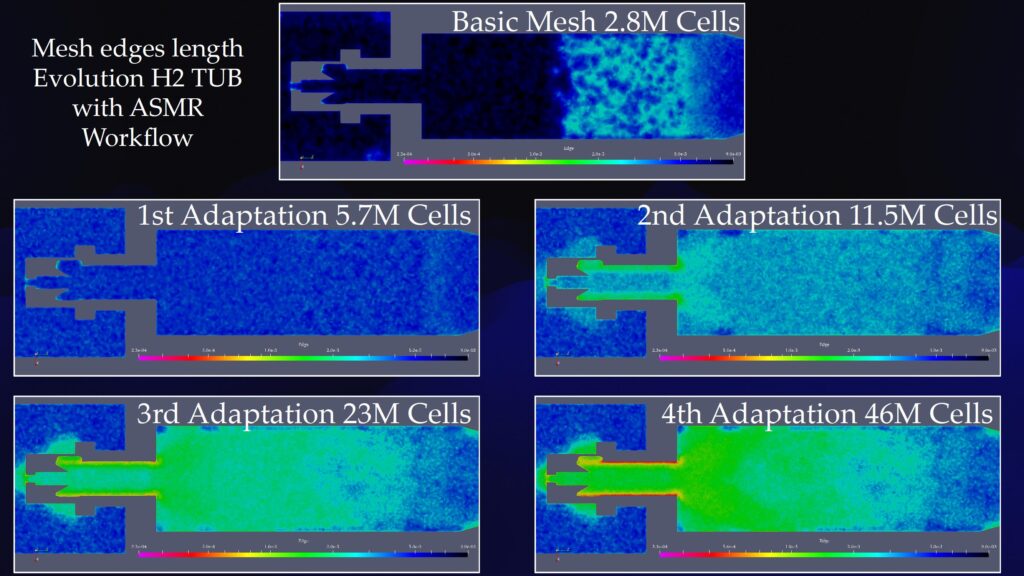Success Story: Automated workflow for the Hi-fidelity simulation of propulsion devices: application to after burners

success story # highlights:
- Keywords:
- Automated workflow
- Reactive simulation
- Industry sector: Aeronautics, Energy, Manufacturing &
engineering, Mechanical engineering - Key codes used: AVBP, PyHIP, Kalpataru, Lemmings, Tekigo
Collaboration with industrial users
Benefits:

- Affordable simulations: The simulation can be adapted to available resources because the number of final degrees of freedom is directly input by the user.
- Lower manpower: The automation decreases the need for run supervision, while the traceability and logs accelerate runtime. This saves up to three quarters (75%) of the supervision time previously necessary.
- Resource optimisation: The automation ensures a progressive and reasonable usage of resources. This avoids run outliers in performance or set-ups.

Organisations Involved:

Cerfacs is a science center that produces innovative solutions for the simulation of earth physics and engineering. Backed by seven public and private partners, supported by European and national research projects, it is focused on research and training for high performance simulation. Cerfacs developed the simulation workflow.

Safran Aircraft Engines draws on a legacy reaching back over 110 years to design, develop, produce and market, alone or in partnership, engines for civil and military aircraft. It tested and deployed the workflow on one of their actual after-burner studies.
excellerat products and services:
Lemmings: an open-source helper for packaging simulation workflows with little work. It is a pure python package available on PyPI.
PyHIP: a mesh handler tool used in the workflow as a wrapper for the MMG3D remeshing library (sequential remeshings). It is a C and python package available on PyPI.
Kalpataru: A hierarchical graph/mesh partitioning tool used in the workflow as a wrapper for the MMG3D remeshing library (parallel remeshings). It is a C++ library available on https://gitlab.com/cerfacs.
Tekigo: A python tool used to compute and merge different remeshing criteria into a single metric. It is a pure python package available on PyPI.
AVBP: A high fidelity solver for reactive simulations. The codebase is in Fortran90, available upon request from Cerfacs through a Non Disclosure Agreement.
technical challenge:
The decarbonation and depollution efforts of Safran Group are pushing the innovation of new burner technologies forward. However, the volume of after-burner flames and the unpredictability of newer fuels such as hydrogen flames are challenging the meshing practices born of more classical, no longer computationally affordable configurations.

Solution:
The first corner stone of the project was the creation of “Lemmings” during EXCELLERAT P1, a tool to package run workflows with low effort. Compared to job chaining, it provides portability, low impact on queues, exhaustive logging, and traceability of job sequences. Second was the creation of a remeshing criterium independent of the mesh resolution but globally controlled by the user. This was previously done by the Center of Excellence for Combustion (COEC) using Tekigo. Finally, the robustness of PyHIP and the performance of Kalpataru, both remeshing tools backed by EXCELLERAT P2, pushed the solution to maturity.
The close collaboration and support of Safran Group engineers grounded the work in purpose and practicality, and the fact that the prototype version is already in the hands of the end users proves its maturity.
alternative Solution / at the moment:
A first version of the Automated Static Mesh Refinement workflow (ASMR) has been successfully tested by Safran engineers. This workflow allows for fast exploration and feedback on new meshes directly based on the physical phenomena observed and computational resources available. At the moment, the mesh adaptation is done sequentially (using pyHip), the ASMR is fully operational up to 200 million tetrahedrons, and it is already deployed as an early prototype by the end user. A Cerfacs team is currently working on a second version that uses parallel instead of sequential mesh adaptation.

impact:
Safran Group developed the capability to routinely execute high fidelity simulations during the after-burner design process. Without this workflow, the computational cost would have limited these simulations to exceptional runs on a case-by-case basis.
The same workflow is being evaluated for other Safran design fields: ignition phases, cruise runs, turbomachinery. An interesting feature is emerging: The meshes created by the workflow are born of physical meshing criteria, while current meshing practices come from years of experience. Comparing the two kinds of meshes is shedding a new light on present simulation practices.
A last but noticeable surprise was observed by user support. As a greater share of simulations are created via automated tools, the runs are more homogenous, with a higher traceability. User support reported that after an initial surge, less support was requested in the long run. This explains why this workflow, initially required by industrial users, is now also slowly gaining traction with academic users for simulations with lower technology readiness levels, especially for highly unpredictable hydrogen burners.
Potential EXCELLERAT Services:
1) The Lemmings workflow can be adapted to any simulation and meshing software, as long as the simulation process can be expressed as recursive runs with stop criteria. If remeshing is included, the target degrees of freedom must be a user input.
2) The mix of meshing criteria being physics based and normalised are not specific to the simulation technique and could be used for alternative approaches (LBM, Spectral Differences).
unique value of each service:
1) The Lemmings workflow is unique because it is small, lightweight, and yet complies with most cluster policies. It never submits more than one job at a time, avoiding flurries and providing excellent traceability.
2) KalpaTaru offers exceptional performance in mesh partition and adaptation, with excellent scaling over thousands of domain decompositions. Its modular structure using templates also allows for easy extension to other remeshing libraries.

